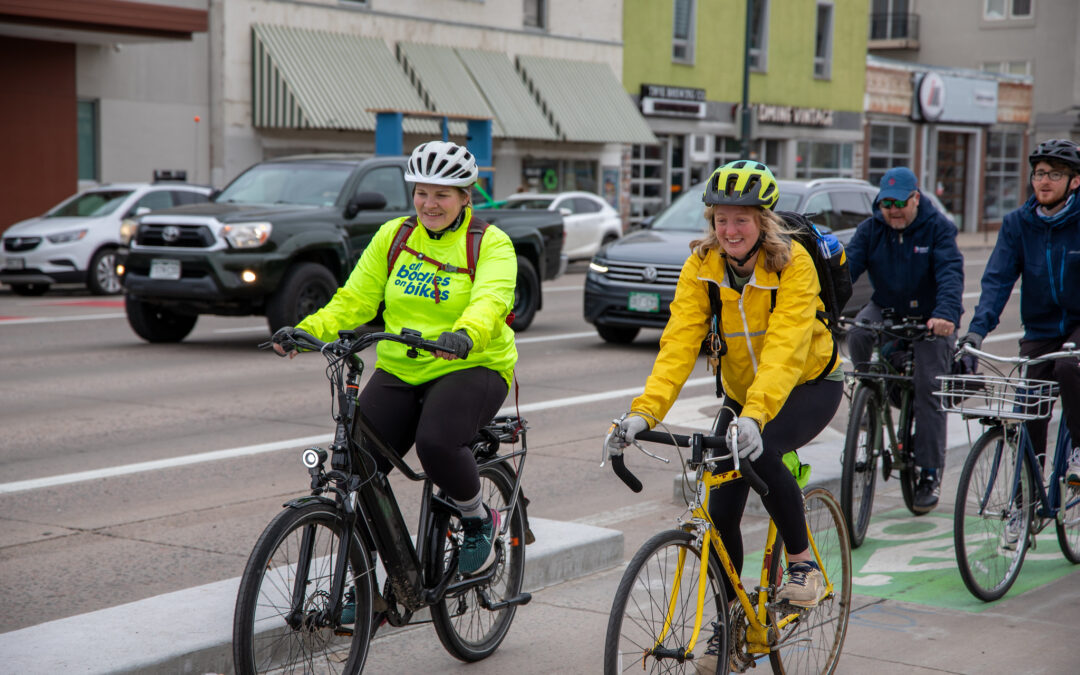By Jill Locantore
At the end of his term in 2023, Denver Mayor Hancock celebrated the installation of 137 miles of new bike lanes over five years. While safe streets advocates (ourselves included) might quibble over how one measures “one mile” of bike lanes (if there are lanes on both sides of the street, does that double the mileage?), or the quality of some of the bike lanes that were counted (does a sharrow really make a street comfortable to bike on?), the outcome of his administration’s efforts was a significant step forward in the buildout of a complete bike network across Denver. The initiative also saw the inevitable “bikelash” from residents complaining about the inconvenience to drivers (despite ample evidence that bike lanes make streets safer for everybody, including drivers), and aesthetics (remember 7th Avenue?).
It’s great news, then, that Mayor Johnston’s administration isn’t declaring the job done and moving on to other priorities, but instead is updating the Denver Moves: Bikes plan to help the Department of Transportation and Infrastructure (DOTI) build even more comfortable and connected bikeways—the current draft identifies more than 230 miles of new facilities—and develop an ongoing program to upgrade Denver’s existing bikeways over time. DOTI is seeking public feedback on the updated bike network map, so now’s the time to advocate for filling those critical remaining gaps in the network (like that spot on 17th Street downtown where the bike lane just disappears at Tremont, effectively throwing unsuspecting bicyclists off a cliff) and upgrading those existing bike facilities that don’t quite live up to their promise of “high comfort” (more vertical separation, speed humps, mini traffic circles, and traffic diverters, please!).
At the Denver Streets Partnership, we are particularly excited to see the draft map include a whole new concept not included in previous versions of the plan: a “Core Network” of bike routes. Just like people driving can take bigger streets like Colfax, Broadway, Federal, Colorado, and Alameda when they want to leave their neighborhood and get across town more quickly, people biking for daily transportation purposes need these kinds of arterial routes too. To truly serve this transportation need, the Core Network should have a few key characteristics:
- Direct routes — On a leisurely bike ride around your neighborhood, zig-zagging from one street to another might not be a big deal, but when you’re trying to get across town, these meandering routes require complex planning ahead of time and constant vigilance for wayfinding signs that might not even exist when you need them. You should be able to get on the Core Network and bike in a straight line, or as close to one as possible, for miles.
- Direct access to destinations — When you’re biking for transportation, you’re trying to actually get somewhere, and that can be difficult when the safe and comfortable bike route is on a parallel street a block or two away from where all the shops, restaurants, offices, schools, service providers, etc. are located. The new Broadway bikeway is excellent proof that bike facilities can and should be included on “Main Streets” where all the destinations are. As DOTI and the Colorado Department of Transportation (CDOT) plan for the build out of the Denver area’s Bus Rapid Transit (BRT) network and consider major changes to arterials that traditionally have been just for cars, it provides a great opportunity to include Core Network bike facilities as well.
- Capacity — Now that Denver’s got more and more fully protected bike lanes, with vertical separation from cars, how often have you gotten stuck behind another person biking slower than you would like (an increasing problem with the growing adoption of e-bikes) or been frustrated that you can’t ride side-by-side with friends or family who are traveling with you (the social aspect being one of the many reasons biking is such a pleasurable way to get around)? For decades, we’ve been widening roads to make more room for cars; it’s time to widen bike lanes to make more room for people biking and rolling, particularly on the Core Network.
- Regular spacing throughout the city — The Core Network isn’t that useful if you have to go far out of your way just to get on it. Ideally, the Core Network should be a grid of north-south and east-west routes, spaced one half to one mile apart, so folks in any neighborhood can hop on with ease.
- Safety and comfort — Of course every bike facility should be safe and comfortable, but extra measures will be required to ensure this on the Core Network, which will inevitably run along bigger streets with higher volumes of cars, because that’s where the destinations are. Not only should these larger streets include robust barriers between cars and bikes and designs that facilitate safe crossings at busy intersections, but they will also need additional features such as trees and greenery to ensure that it’s actually enjoyable to bike on them. Repurposing space on these bigger streets to prioritize people on bikes (and on transit and walking) can lead to a virtuous cycle where more people choose options other than driving, thus decreasing the speed and volume of car traffic, and making the street more enjoyable for everyone.
To show your support for the idea of a Core Network, help ensure it includes the features outlined above, and provide input on the full map of proposed new bikeways and bikeway upgrades, you can use DOTI’s Online Feedback Tool or attend DOTI’s virtual open house on August 7, 5:30–7:00 p.m.

